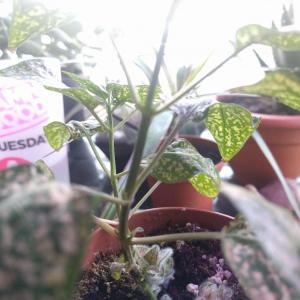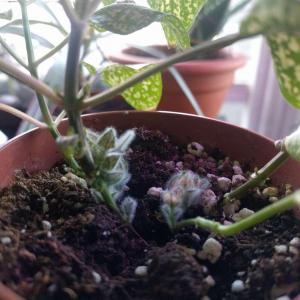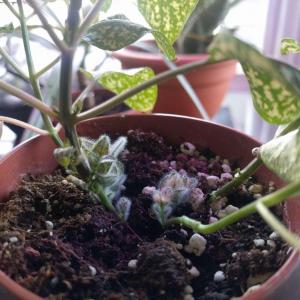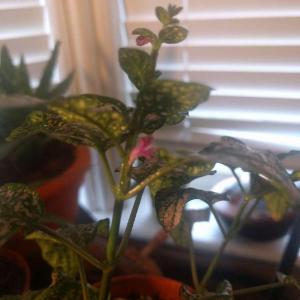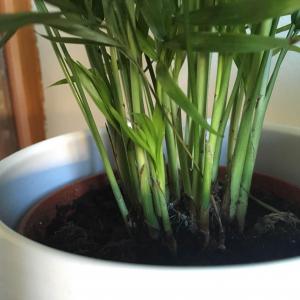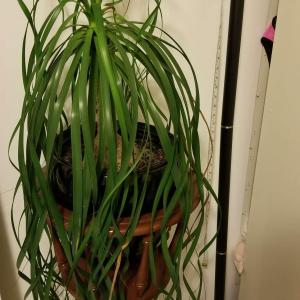文章
Miss Chen
2018年03月31日

Description: This herbaceous perennial plant is 1-2' tall, branching occasionally. The stems are sharply 4-angled and usually glabrous, although scattered hairs may occur along the ridges on relatively new growth. The opposite leaves are up to 3½" long and 2" across. They are sessile against the stem, or have very short petioles. The leaves are broadly lanceolate or ovate, with serrate margins that are often ciliate. The upper surface of each leaf is often finely pubescent, while a few hairs may occur along the major veins on the lower surface. The upper surface is green or yellowish green, sometimes with scattered purple spots or a purplish tint along the margin. The upper stems terminate in dome-shaped flowerheads (a single flowerhead per stem). These flowerheads are about 1½–3" across. A small wreath of flowers first appears toward the center of the flowerhead, and spreads gradually towards the outer edge of the flowerhead.
Each narrow flower is about 1" long, and has a corolla that is deeply divided into prominent upper and lower lips. The upper lip is nearly tubular and contains the exerted stamens, while the lower lip is somewhat wider and has a narrow lobe at its tip that curls downward. The corolla is white or pink, with purple dots on the lower lip, and white hairs on the upper lip. The calyx of each flower is tubular and hairy, with 5 pointed lobes at its tip. Immediately beneath each flowerhead are 5 leafy bracts that are triangular-shaped. These bracts often have ciliate margins, and they are often colored faded pink or purple. The blooming period occurs during the late spring or early summer and lasts about a month. There is no floral scent, although the foliage exudes an oregano scent. The nutlets are dispersed to some extent by the wind. The root system produces abundant rhizomes, enabling vegetative reproduction.
Cultivation: The preference is partial sun and somewhat dry conditions. This species often grows in soil that is somewhat thin and rocky, which reduces competition from other species of plants. The lower leaves will fall off the stems during drought; in stressed-out plants, the foliage may become discolored and diseased.

Range & Habitat: The native Bradbury's Bee Balm occurs occasionally in the southern half of Illinois, while elsewhere within the state it is rare or absent (see Distribution Map). Habitats include rocky upland forests, savannas, thickets, limestone or sandstone glades, bluffs, meadows in wooded areas, pastures, and roadsides. This species probably benefits from occasional wildfires to create clearings in woodland areas.
Faunal Associations: Long-tongued bees (especially bumblebees), butterflies, skippers, Hummingbird moths, beeflies, and hummingbirds visit the flowers for nectar. The small black bee Doufourea monardae is a specialist pollinator of Monarda spp. Short-tongued Halictid bees may visit the flowers to collect pollen; they are unable to reach the nectar. Caterpillars of the moths Sphinx eremitus (Hermit Sphinx), Anterastria teratophora (Gray Marvel), Pyrausta orphisalis (Pyralid Moth sp.), and Pyrausta signatalis (Pyralid Moth sp.) feed destructively on Monarda spp. (Bee Balms). Other insect feeders include the scentless plant bug Arhyssus nigristernum, the leaf-footed bug Euthochtha galeator, the aphid Hyalomyzus monardae, and the leaf beetle Physonota unipunctata. Mammalian herbivores usually avoid consumption of Monarda spp. – it is possible that the oregano scent of the foliage deters them.

Photographic Location: An upland savanna at Warbler Woods in Coles County, Illinois, and a restored prairie at Meadowbrook Park in Urbana, Illinois.
Comments: Bradbury's Bee Balm is fairly easy to identify. Like other Monarda spp., the large flowers have a distinctive appearance that is showy and attractive. Bradbury' Bee Balm differs from other Monarda spp. in Illinois by its sessile or nearly sessile leaves, and the purple dots on the lower lip of the corolla. It is also shorter in stature and blooms earlier. The species Monarda russeliana of some authors is probably the same species as Monarda bradburiana.
Each narrow flower is about 1" long, and has a corolla that is deeply divided into prominent upper and lower lips. The upper lip is nearly tubular and contains the exerted stamens, while the lower lip is somewhat wider and has a narrow lobe at its tip that curls downward. The corolla is white or pink, with purple dots on the lower lip, and white hairs on the upper lip. The calyx of each flower is tubular and hairy, with 5 pointed lobes at its tip. Immediately beneath each flowerhead are 5 leafy bracts that are triangular-shaped. These bracts often have ciliate margins, and they are often colored faded pink or purple. The blooming period occurs during the late spring or early summer and lasts about a month. There is no floral scent, although the foliage exudes an oregano scent. The nutlets are dispersed to some extent by the wind. The root system produces abundant rhizomes, enabling vegetative reproduction.
Cultivation: The preference is partial sun and somewhat dry conditions. This species often grows in soil that is somewhat thin and rocky, which reduces competition from other species of plants. The lower leaves will fall off the stems during drought; in stressed-out plants, the foliage may become discolored and diseased.

Range & Habitat: The native Bradbury's Bee Balm occurs occasionally in the southern half of Illinois, while elsewhere within the state it is rare or absent (see Distribution Map). Habitats include rocky upland forests, savannas, thickets, limestone or sandstone glades, bluffs, meadows in wooded areas, pastures, and roadsides. This species probably benefits from occasional wildfires to create clearings in woodland areas.
Faunal Associations: Long-tongued bees (especially bumblebees), butterflies, skippers, Hummingbird moths, beeflies, and hummingbirds visit the flowers for nectar. The small black bee Doufourea monardae is a specialist pollinator of Monarda spp. Short-tongued Halictid bees may visit the flowers to collect pollen; they are unable to reach the nectar. Caterpillars of the moths Sphinx eremitus (Hermit Sphinx), Anterastria teratophora (Gray Marvel), Pyrausta orphisalis (Pyralid Moth sp.), and Pyrausta signatalis (Pyralid Moth sp.) feed destructively on Monarda spp. (Bee Balms). Other insect feeders include the scentless plant bug Arhyssus nigristernum, the leaf-footed bug Euthochtha galeator, the aphid Hyalomyzus monardae, and the leaf beetle Physonota unipunctata. Mammalian herbivores usually avoid consumption of Monarda spp. – it is possible that the oregano scent of the foliage deters them.

Photographic Location: An upland savanna at Warbler Woods in Coles County, Illinois, and a restored prairie at Meadowbrook Park in Urbana, Illinois.
Comments: Bradbury's Bee Balm is fairly easy to identify. Like other Monarda spp., the large flowers have a distinctive appearance that is showy and attractive. Bradbury' Bee Balm differs from other Monarda spp. in Illinois by its sessile or nearly sessile leaves, and the purple dots on the lower lip of the corolla. It is also shorter in stature and blooms earlier. The species Monarda russeliana of some authors is probably the same species as Monarda bradburiana.
0
0
文章
Miss Chen
2018年03月16日

Squash plants make up a large and diverse group of plants that fall under the genus Cucurbita. Common to all squashes is their vining growth, large, dark green leaves and yellow to orange flowers. They are divided into two main types, summer and winter squash, based on their time of harvest. The appearance and characteristics of squash fruit ranges widely, from small green zucchinis to giant orange pumpkins.

Foliage and Flowers
Squash leaves tend to be very large and exhibit three to five lobes. The plant's fruits, flowers, seeds and shoots are edible, along with the leaves. Flowers are large, trumpet-shaped, yellow to orange in color and have separate males and females. Male flowers produce pollen while female flowers mature into fruit. Whether you're growing winter or summer squash, the fruit provides an abundant and continuous harvest.
Summer Squash
Summer types often grow in a compact, bushing fashion with fruit that is usually smaller than winter squash. Harvest summer squash when fruit is still soft and immature, 50 to 65 days after planting. Zucchini is a green summer variety that is quickly ready for picking. Pick it when it reaches 4 to 5 inches in length, but pick varieties like Costata Romanesco when they reach 6 to 10 inches long. This variety produces many male blossoms, ideal for frying and eating. Yellow summer squash includes both straightneck and crookneck types.
Winter Squash
The key to growing winter squash is to allow plenty of room for each plant to spread. These plants can take over a garden with their fast-growing vines. Harvest when fruit is large and mature, usually in fall or winter, 80 to 120 days after sowing. Many types require curing to harden the shell, and are best if baked prior to consumption. The main varieties of winter squash include acorn, buttercup and butternut varieties. Acorn squash is just 2 pounds in weight with a slightly tapered, round acorn shape. Buttercup squash is similar to acorn squash, but larger and slighly flattened. Many of them, including the Sweet Mama cultivar, store well and easily last until February. Butternut squash is tan-colored, exhibits a sweet flavor and has a cylindrical shape with a bulb on the bottom end.

Growth Requirements
Squash plants are heavy feeders that grow quickly. They prefer plenty of heat during germination. For summer squash, ideal germinating soil temperature is 95 F, while winter squash germinates best at about 90 F. Direct sowing is best with these plants as they grow fast and do not transplant well. Provide rich, well-drained soil. Winter squash especially needs rich soil as it has a longer growing time and needs more nitrogen than its summertime counterpart. Harvest summer squash as soon as the fruit grows large enough, but do not allow it to over ripen or grow wrinkled in appearance. For winter squash, wait until stems dry and shrivel and skin is hard. Then cure the squash in the sun so the skin can dry completely.

Foliage and Flowers
Squash leaves tend to be very large and exhibit three to five lobes. The plant's fruits, flowers, seeds and shoots are edible, along with the leaves. Flowers are large, trumpet-shaped, yellow to orange in color and have separate males and females. Male flowers produce pollen while female flowers mature into fruit. Whether you're growing winter or summer squash, the fruit provides an abundant and continuous harvest.
Summer Squash
Summer types often grow in a compact, bushing fashion with fruit that is usually smaller than winter squash. Harvest summer squash when fruit is still soft and immature, 50 to 65 days after planting. Zucchini is a green summer variety that is quickly ready for picking. Pick it when it reaches 4 to 5 inches in length, but pick varieties like Costata Romanesco when they reach 6 to 10 inches long. This variety produces many male blossoms, ideal for frying and eating. Yellow summer squash includes both straightneck and crookneck types.
Winter Squash
The key to growing winter squash is to allow plenty of room for each plant to spread. These plants can take over a garden with their fast-growing vines. Harvest when fruit is large and mature, usually in fall or winter, 80 to 120 days after sowing. Many types require curing to harden the shell, and are best if baked prior to consumption. The main varieties of winter squash include acorn, buttercup and butternut varieties. Acorn squash is just 2 pounds in weight with a slightly tapered, round acorn shape. Buttercup squash is similar to acorn squash, but larger and slighly flattened. Many of them, including the Sweet Mama cultivar, store well and easily last until February. Butternut squash is tan-colored, exhibits a sweet flavor and has a cylindrical shape with a bulb on the bottom end.

Growth Requirements
Squash plants are heavy feeders that grow quickly. They prefer plenty of heat during germination. For summer squash, ideal germinating soil temperature is 95 F, while winter squash germinates best at about 90 F. Direct sowing is best with these plants as they grow fast and do not transplant well. Provide rich, well-drained soil. Winter squash especially needs rich soil as it has a longer growing time and needs more nitrogen than its summertime counterpart. Harvest summer squash as soon as the fruit grows large enough, but do not allow it to over ripen or grow wrinkled in appearance. For winter squash, wait until stems dry and shrivel and skin is hard. Then cure the squash in the sun so the skin can dry completely.
0
0
文章
Miss Chen
2018年03月16日


While it's more common to have bumper crops of fast-growing zucchini (Cucurbita pepo), some factors can slow down the growth of your annual zucchini or make the plant produce small fruit. For most summer squash, like zucchini, small, young zucchini are more tender and flavorful, but if you want larger zucchini for stuffing, there are some things to do to ensure your zucchini grow well. Trimming the leaves is not one of those things.
Leave the Leaves Alone
The leaves are the food manufacturers for the plant. The large, abundant leaves on a zucchini plant provide shade and keep out weeds by blocking sunlight from reaching the soil and providing nourishment for the weeds. If you cut off the leaves, your zucchini loses its source of fuel, and may slow its growth. Don't bother your zucchini's leaves and look to other ways to improve growth.
Poor Pollination
The most common reason for tiny zucchini that drop off the plant is poor pollination. Bees may not be visiting your garden due to weather extremes or because you've used insecticides. If a lack of bees in your area are keeping your zucchini from growing to their full potential, you need to hand pollinate the plants. Pull off the male flowers. which have a long, thin, straight stem at the base, and touch the center of it to the centers of the female flowers that appear a day later and have a bulbous growth at their bases.

Fertilizer Fouls
Too much or too little fertilizer can cause your zucchini to not grow as large as you want. If you over-fertilize, the plant produces more leaves instead of concentrating its growth on the zucchini, but this does not mean that you need to remove those leaves. Because zucchini plants grow quickly, they are heavy feeders, which means if you don't give them enough fertilizer, their growth and the plant's yield can suffer. Both of these cases can be remedied by improving your fertilization techniques, quantities and method.
When you plant the zucchini, sprinkle 1 tablespoon per hill of a fertilizer that has more potassium and phosphorous in it than nitrogen, for instance a 6-10-10. One week after the blooms appear, apply 1 tablespoon of pure nitrogen fertilizer next to the plants, and repeat this side dressing three weeks later to ensure the proper amount of nitrogen in the soil as the zucchini are growing larger and require more nitrogen.
Watering Woes
Water stress may impact the size of your zucchini. This usually occurs when an exceptionally dry period is followed by heavy watering. Whether you just went out of town for a week and could not water your garden or if you forgot, these fluctuations in moisture can create small, misshapen fruit on the zucchini bush. Water your zucchinis weekly so the soil feels moist down 6 to 8 inches below the surface, but don't get water on the leaves, which can spread diseases. Drip irrigation is the best as it delivers water straight to where the zucchini needs it, and you can get under the leaves, which help to conserve moisture in the soil by blocking the sun from the soil, which is another reason to leave the leaves on the plant.
0
0
成长记
Avacha
2018年02月21日

The plant is feeling the spring coming! It grows in all directions. Maybe next winter we can even see its blossom? 😊🌺 #schlumbergera #growth #Gamora

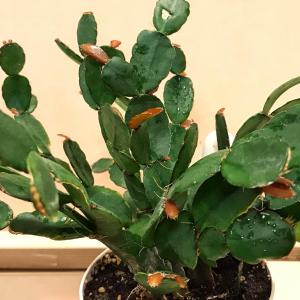


0
0
Lisa Stout
2018年02月14日

After rooting this purple flowering tradescantia indoors in water; its been 2 weeks and I've got new growth but no roots... 🤔




0
0
成长记
cclecombe
2018年02月12日

From a distance this is looking a little worse for wear but there’s some impressive new growth coming along!








0
0
成长记
cclecombe
2018年02月12日

This guy has been doing suprisingly well over winter! This is a plant I need to update more regularly because its growth is so impressive!


0
0
成长记
cclecombe
2018年02月12日

I need to photograph this plant more frequently cus its movement and growth is crazy!


0
0
文章
Miss Chen
2018年02月08日

Description: This plant is a summer annual or biennial that is erect and eventually becomes ¾–2½' tall. Some plants overwinter as a low rosette of leaves, while others complete their growth and development within a single year. After the rosette stage has passed, each plant has a central stem that is unbranched in the lower half, while short ascending branches develop in the upper half. The central and upper stems are whitish green to nearly white from the appressed woolly hairs that cover their surfaces. The alternate leaves are up to 3" long and 1/3" (8 mm.) across, becoming slowly smaller as they ascend the stems. The leaves are linear-oblong, smooth or minutely undulate along their margins, and sessile. The upper surface of each leaf is mostly hairless and dark green to yellowish green, while the lower surface is whitish green and covered with appressed woolly hairs. Each leaf has a prominent central vein.
Compound Corymbs of Flowerheads
Each upper stem terminates in a small corymb of 1-5 flowerheads; they are white to cream-colored. Each flowerhead is about ¼" long and about half as much across; it is conical-oblongoid in shape with a truncate apex. Later, each flowerhead becomes wider and more open as its achenes become mature. The sides of each flowerhead consist of many overlapping bracts that are white or cream-colored; these scale-like bracts are oblong-lanceolate to broadly oblong-lanceolate and they have blunt tips. At the apex of each flowerhead, there are many disk florets that are pale yellow to light brown; the innermost florets are perfect (both staminate and pistillate), while the remaining florets are pistillate. Each tiny floret is narrowly tubular. The blooming period occurs from late summer to early fall and lasts about a month. There is no noticeable floral scent, although the foliage often has a balsam-like fragrance. Each floret is replaced with a small bullet-shaped achene that has a tuft of white hairs at its apex. These hairs can separate from each other individually or in small groups; they are not united at the base. The root system is mostly fibrous. This plant spreads by reseeding itself.
Cultivation: The preference is full sun, mesic to dry conditions, and a friable soil containing sand or silt. A little shade is tolerated. The seeds require light to germinate.
Range & Habitat: The native Sweet Everlasting is occasional to locally common throughout Illinois (see Distribution Map). Habitats include upland prairies, sand prairies, typical savannas and sandy savannas, fallow fields, and areas along railroads and roadsides. Disturbed dry areas with scant vegetation are preferred.

Faunal Associations: The nectar of the flowers attracts short-tongued bees (mainly Halictid), wasps, and flies primarily. Among the wasps, are such visitors as Eumenid wasps, Crabronid wasps, Paper wasps, Spider wasps, Cuckoo wasps, Weevil wasps, and many others (see Robertson, 1929). The Wild Turkey reportedly eats the foliage. White-Tailed Deer browse on the foliage during the winter.
Photographic Location: At the edge of a field in Vermilion County, Illinois.
Comments: This curious plant has woolly foliage and flowerheads that resemble those of Antennaria spp. (Pussytoes), Anaphalis margaritacea (Pearly Everlasting), Gamochaeta purpurea. (Early Cudweed), and some other members of the Aster family. Sweet Everlasting is more tall than Pussytoes and Early Cudweed, and its truncate-conical flowerheads are more narrow than the button-like flowerheads of Pearly Everlasting. There are other Pseudognaphalium spp. in the United States that are quite similar in appearance to Sweet Everlasting, but they have not been observed in Illinois. However, some of these species have been found in neighboring Indiana and other states further to the east. Sweet Everlasting's older scientific name is Gnaphalium obtusifolium (by which it is still commonly referred), but it has been reassigned to the genus Pseudognaphalium.
Compound Corymbs of Flowerheads
Each upper stem terminates in a small corymb of 1-5 flowerheads; they are white to cream-colored. Each flowerhead is about ¼" long and about half as much across; it is conical-oblongoid in shape with a truncate apex. Later, each flowerhead becomes wider and more open as its achenes become mature. The sides of each flowerhead consist of many overlapping bracts that are white or cream-colored; these scale-like bracts are oblong-lanceolate to broadly oblong-lanceolate and they have blunt tips. At the apex of each flowerhead, there are many disk florets that are pale yellow to light brown; the innermost florets are perfect (both staminate and pistillate), while the remaining florets are pistillate. Each tiny floret is narrowly tubular. The blooming period occurs from late summer to early fall and lasts about a month. There is no noticeable floral scent, although the foliage often has a balsam-like fragrance. Each floret is replaced with a small bullet-shaped achene that has a tuft of white hairs at its apex. These hairs can separate from each other individually or in small groups; they are not united at the base. The root system is mostly fibrous. This plant spreads by reseeding itself.
Cultivation: The preference is full sun, mesic to dry conditions, and a friable soil containing sand or silt. A little shade is tolerated. The seeds require light to germinate.
Range & Habitat: The native Sweet Everlasting is occasional to locally common throughout Illinois (see Distribution Map). Habitats include upland prairies, sand prairies, typical savannas and sandy savannas, fallow fields, and areas along railroads and roadsides. Disturbed dry areas with scant vegetation are preferred.

Faunal Associations: The nectar of the flowers attracts short-tongued bees (mainly Halictid), wasps, and flies primarily. Among the wasps, are such visitors as Eumenid wasps, Crabronid wasps, Paper wasps, Spider wasps, Cuckoo wasps, Weevil wasps, and many others (see Robertson, 1929). The Wild Turkey reportedly eats the foliage. White-Tailed Deer browse on the foliage during the winter.
Photographic Location: At the edge of a field in Vermilion County, Illinois.
Comments: This curious plant has woolly foliage and flowerheads that resemble those of Antennaria spp. (Pussytoes), Anaphalis margaritacea (Pearly Everlasting), Gamochaeta purpurea. (Early Cudweed), and some other members of the Aster family. Sweet Everlasting is more tall than Pussytoes and Early Cudweed, and its truncate-conical flowerheads are more narrow than the button-like flowerheads of Pearly Everlasting. There are other Pseudognaphalium spp. in the United States that are quite similar in appearance to Sweet Everlasting, but they have not been observed in Illinois. However, some of these species have been found in neighboring Indiana and other states further to the east. Sweet Everlasting's older scientific name is Gnaphalium obtusifolium (by which it is still commonly referred), but it has been reassigned to the genus Pseudognaphalium.
0
0
文章
Miss Chen
2018年02月07日

Description: This annual plant is about 2' tall and largely unbranched, except near the base. The major stems are stout, round, and covered with rather long glandular hairs, especially where new growth occurs. The lower and middle compound leaves along the stems are trifoliate with long petioles. The individual leaflets are about 1½" long and ½" across. They are oval, ovate, or oblong, and have smooth margins that are slightly ciliate. Their surface is dull green and covered with short fuzzy hairs, with longer hairs occurring along the lower central vein. When the foliage is bruised or rubbed against, a fetid odor is emitted. Smaller leaves on short petioles occur along the upper stems that are simple, rather than compound. The major stems terminate in racemes of flowers of variable length – these flowers are whorled near the apex of the stems with scattered seedpods below. Each flower is about 1" across and has an unusual structure. There are 4 white petals about ½" long that are heart-shaped, but with a long narrow base. About 8-12 strongly exerted stamens are reddish purple and rather unequal in length, with the upper stamens about twice the length of the petals. The single slender style is much shorter than the stamens and less conspicuous. At the base of each flower, is a gland that secretes a conspicuous drop of bright red fluid. The calyx is divided into 4 triangular sepals that are reddish purple. The flowers occur on long hairy pedicels.
The blooming period occurs from summer until the fall, and can last several months. There is no obvious floral scent. Pollinated flowers develop sizeable seedpods up to 3" long that are sessile against the pedicels (i.e., there is no stipular growth at the base of the seedpods). These seedpods resemble stout bean pods that can divide into two halves. Each seedpod has fuzzy hairs on the outer surface, and forms a long terminal spike that withers away as the seedpod matures. Mature seedpods are held more or less erect, rather than drooping downward from the stems. The individual seeds have an irregular patterned surface. The root system consists of a long taproot without rhizomes. This plant spreads by reseeding itself.
Cultivation: It is best to growth this plant in full sunlight, mesic to dry conditions, and soil that is rocky or sandy. The base of the central stem of this plant may sprawl along the ground if it is grown in moist, fertile soil. Foliar disease and insect pests are not generally troublesome.

Range & Habitat: Large-Flowered Clammyweed is an uncommon plant that occurs in widely scattered counties in Illinois (see Distribution Map), where it is probably native. This plant is more common in areas that lie to the west of Illinois. Within the state, it has been found in such natural habitats as openings in bluffs, glades, or hill prairies, and may occur occasionally as an adventive plant along railroads. Because of the ornamental flowers, this plant can be found in flower gardens, but this is uncommon.
Faunal Associations: Various bees visit the flowers for nectar, while flower flies feed on the pollen from the exerted anthers. However, the latter group of insects does not effectively pollinate the flowers. The foliage is not known to be toxic to mammalian herbivores, notwithstanding the fetid odor, but little appears to be known about the attractiveness of the foliage as a food source. Similarly, little is known about the attractiveness of the seeds to small rodents or upland gamebirds. Because the seeds of similar kinds of plants, such as the Cleome spp. (Bee Plants) in the western states, are occasionally eaten by the Ring-Necked Pheasant, Mourning Dove, and various small rodents, it is possible that the same or similar species also eat the seeds of Polanisia spp. (Clammyweeds).

Photographic Location: The edge of vegetable garden in Meadowbrook Park, Urbana, Illinois. The plant was blooming during early September.
Comments: Large-Flowered Clammyweed is primarily a western species, and Illinois lies on the eastern edge of its distribution. It is fairly attractive while in bloom and has some resemblance to Cleome hassleriana (Spider Flower) of mass-market horticulture. This latter species is a larger plant from South America with palmate compound leaves. The more typical variety of Clammyweed, Polanisia dodecandra dodecandra, has smaller flowers with petals about ¼" and stamens that are barely longer than the petals. It less showy than the variety of Clammyweed that is described here, and it has a more eastern distribution. An uncommon species of Clammyweed, Polanisia jamesii (James' Clammyweed), is a sand prairie species that has narrow leaflets and flower petals with irregular fringed edges. What distinguishes the Polanisia spp. (Clammyweeds) from the Cleome spp. (Bee Plants) is the lack of a stipe connecting the seedpod with the pedicel. This stipe of the Bee Plants is a stalk-like extension of the developing seedpod. Both groups of plants are members of the Caper family.
The blooming period occurs from summer until the fall, and can last several months. There is no obvious floral scent. Pollinated flowers develop sizeable seedpods up to 3" long that are sessile against the pedicels (i.e., there is no stipular growth at the base of the seedpods). These seedpods resemble stout bean pods that can divide into two halves. Each seedpod has fuzzy hairs on the outer surface, and forms a long terminal spike that withers away as the seedpod matures. Mature seedpods are held more or less erect, rather than drooping downward from the stems. The individual seeds have an irregular patterned surface. The root system consists of a long taproot without rhizomes. This plant spreads by reseeding itself.
Cultivation: It is best to growth this plant in full sunlight, mesic to dry conditions, and soil that is rocky or sandy. The base of the central stem of this plant may sprawl along the ground if it is grown in moist, fertile soil. Foliar disease and insect pests are not generally troublesome.

Range & Habitat: Large-Flowered Clammyweed is an uncommon plant that occurs in widely scattered counties in Illinois (see Distribution Map), where it is probably native. This plant is more common in areas that lie to the west of Illinois. Within the state, it has been found in such natural habitats as openings in bluffs, glades, or hill prairies, and may occur occasionally as an adventive plant along railroads. Because of the ornamental flowers, this plant can be found in flower gardens, but this is uncommon.
Faunal Associations: Various bees visit the flowers for nectar, while flower flies feed on the pollen from the exerted anthers. However, the latter group of insects does not effectively pollinate the flowers. The foliage is not known to be toxic to mammalian herbivores, notwithstanding the fetid odor, but little appears to be known about the attractiveness of the foliage as a food source. Similarly, little is known about the attractiveness of the seeds to small rodents or upland gamebirds. Because the seeds of similar kinds of plants, such as the Cleome spp. (Bee Plants) in the western states, are occasionally eaten by the Ring-Necked Pheasant, Mourning Dove, and various small rodents, it is possible that the same or similar species also eat the seeds of Polanisia spp. (Clammyweeds).

Photographic Location: The edge of vegetable garden in Meadowbrook Park, Urbana, Illinois. The plant was blooming during early September.
Comments: Large-Flowered Clammyweed is primarily a western species, and Illinois lies on the eastern edge of its distribution. It is fairly attractive while in bloom and has some resemblance to Cleome hassleriana (Spider Flower) of mass-market horticulture. This latter species is a larger plant from South America with palmate compound leaves. The more typical variety of Clammyweed, Polanisia dodecandra dodecandra, has smaller flowers with petals about ¼" and stamens that are barely longer than the petals. It less showy than the variety of Clammyweed that is described here, and it has a more eastern distribution. An uncommon species of Clammyweed, Polanisia jamesii (James' Clammyweed), is a sand prairie species that has narrow leaflets and flower petals with irregular fringed edges. What distinguishes the Polanisia spp. (Clammyweeds) from the Cleome spp. (Bee Plants) is the lack of a stipe connecting the seedpod with the pedicel. This stipe of the Bee Plants is a stalk-like extension of the developing seedpod. Both groups of plants are members of the Caper family.
0
0





